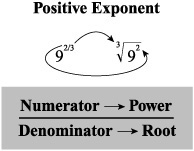Radicals and Roots
In a previous section, you examined the fundamentals of using exponents. You can also express exponents as fractions, and when you do so you enter the realm of roots and radicals. To explore a root, begin with the notion that to discover the power of a number, you begin by multiplying the number by itself, as the discussion in Chapter 2 detailed:
| a × a = a2 | 3 × 3 = 9 | The square of 3 is 9. |
| a × a × a = a3 | 3 × 3 × 3 = 27 | The cube of 3 is 27. |
If you raise 3 by the power of 2, you obtain its square. If you raise 3 by the power of 3, you obtain its cube. Suppose now that you begin with 9 and 27. You ask the following questions:
Given 9, what number can you multiply by itself to arrive at 9? What is the square root of 9?
Given 27, what number can you raise by a power of 3, or multiply by itself three times to arrive at 27? What is the cube root of 27?
To represent a root, you use one of two options. First, you can employ a fractional exponent. The denominator indicates the degree or value of the root. The numerator indicates the power to which you are raising the number. A numerator of 1 allows you to indicate any simple root you choose. As a second option, you can translate the exponent using a radical sign (√). If you use the radical sign alone, by convention it indicates the square root of the number it designates. Here are examples of exponential and radical approaches to expressing roots:

You can work with any number of fractional forms of exponents, and these allow you to express powers and roots simultaneously. Consider the following expression:
![]()
As Figure 3.4 illustrates, positive exponents render radical expressions in which the numerator designates the power and the denominator then serves as the root.
Figure 3.4. With positive fractional exponents, you convert the numerator to the power.

Figure 3.5 illustrates a further extension of such activity. When you work with a negative exponent, the result, as with other exponents, renders the multiplicative inverse of the entire radical expression.
Figure 3.5. Fractional exponents translate into radicals, and negatives behave in the same way as exponents.

Generally, you can manipulate fractional exponential expressions in the same way that you manipulate other fractions. Consider the following expression:
![]()
In this case, the common denominator of ![]() and
and ![]() allows you to perform the multiplication operation by adding the two exponents. This gives you
allows you to perform the multiplication operation by adding the two exponents. This gives you ![]() , which you can then reduce and convert to a radical form.
, which you can then reduce and convert to a radical form.
